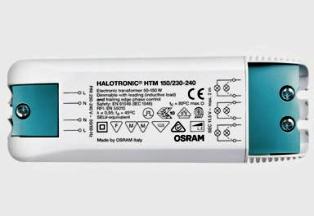Categories: Featured Articles » Electrician at home
Number of views: 53381
Comments on the article: 1
Electronic Transformers: Purpose and Typical Use
Electronic transformer application
 In order to improve the electrical safety conditions of lighting systems, in some cases it is recommended to use lamps not for 220V voltage, but much lower. As a rule, such lighting is arranged in humid rooms: basements, cellars, bathrooms.
In order to improve the electrical safety conditions of lighting systems, in some cases it is recommended to use lamps not for 220V voltage, but much lower. As a rule, such lighting is arranged in humid rooms: basements, cellars, bathrooms.
For these purposes, mainly halogen lamps with a working voltage of 12V. The power of such lamps is provided through electronic transformers, about the internal structure of which will be discussed a little later. In the meantime, a few words about the regular use of these devices.
Externally, the electronic transformer is a small metal or plastic box, from which 4 wires come out: two input with the inscription ~ 220V, and two output ~ 12V.
Everything is quite simple and clear. Electronic transformers allow brightness control with dimmers (thyristor regulators) of course from the input voltage side. It is allowed to connect several electronic transformers to one dimmer at once. Naturally, inclusion without regulators is also possible.
Typical electronic transformer switching circuit shown in figure 1.
Figure 1. A typical circuit for switching on an electronic transformer.
The advantages of electronic transformers, first of all, should be attributed to their small size and weight, which allows you to install them almost anywhere. Some models of modern lighting devices designed for working with halogen lamps contain built-in electronic transformers, sometimes even several. Such a scheme is used, for example, in chandeliers. There are known options when electronic transformers are installed in furniture for the internal lighting of shelves and hangers.
For indoor lighting, transformers can be installed behind a suspended ceiling or behind plasterboard wall coverings in the immediate vicinity of halogen lamps. The length of the connecting wires between the transformer and the lamp is not more than 0.5 - 1 meter, which is due to high currents (at a voltage of 12V and a power of 60W, the current in the load is at least 5A), as well as the high-frequency component of the output voltage of the electronic transformer.
Inductance of the wire increases with increasing frequency, as well as its length. Basically, the length determines the inductance of the wire. At the same time, the total power of the connected lamps should not exceed that indicated on the label of the electronic transformer. To increase the reliability of the entire system as a whole, it is better if the lamp power is lower by 10 - 15% of the power of the transformer.
Fig. 2. Electronic transformer for OSRAM halogen lamps
Here, perhaps, is all that can be said about the typical use of this device. There is one condition that should not be forgotten: electronic transformers do not start without load. Therefore, the bulb must be connected constantly, and the lighting is turned on by a switch installed in the primary network.
But the scope of electronic transformers is not limited to this: simple improvements, often not even requiring opening the case, allow the creation of switching power supplies (UPS) based on the electronic transformer. But before talking about this, you should get acquainted with the device of the transformer itself closer.
In the next article, we will take a closer look at one of the Taschibra electronic transformers, and also conduct a small study of the operation of the transformer.
Boris Aladyshkin
Continuation of the topic: How is an electronic transformer arranged?
See also at bgv.electricianexp.com
:


